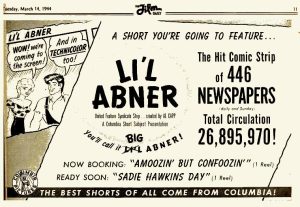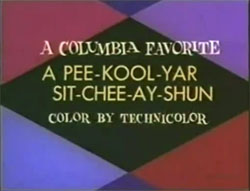


The last years of Columbia’s own cartoon unit seem to have been tumultuous, with a good deal of shifting about in the executive suite. Ray Katz and Eddie Binder come over from Leon Schlesinger’s digs, and become the producers of the cartoons. At that point, original songs and recycled show tunes seem to disappear from production, in favor of original scores by Eddie Kilfeather or Darryl Calker. Eventually, along with the acquisition of Calker, a raid of some Lantz studio employees was staged, allowing for the acquisition of director Alex Lovy, and a general feel in the last years of production as if you were watching Lantz cartoons instead of Warner.
We thus finish off with the last run of music-infused titles from the mid 1940’s. A new short-lived series was added to the roster in the form of Al Capp’s L’il Abner, which would run for only five cartoons. A run of three titles would be produced featuring the super-powered Willoughby Wren, a little guy who gets his unexpected strength from a cap woven from the clipped hair of Samson (none of which feature original songs). And a canary-cat duo of Flippy and Flop would grace several Technicolor episodes, years before the pairing up of Tweety and Sylvester. But all these changes failed to bring in the notoriety and revenue the suits un the main office were hoping for, and the handwriting was on the wall that a further drastic change would take place. It resulted in the closure of the house studio, and the farm-out of work to newcomer UPA. The rest is history.
A Hunting We Won’t Go (4/23/43) – Fox and Crow are actually hunting each other, for the bounty being offered (such as it is). The bounty on each crow is 15 cents. That on foxes is a full quarter. Fox and Crow appear to be rather civil to one another, and for a time quite oblivious to each other’s identity. But they get wise, and eventually Fox gets his chance to shoot crow, only to find he can’t do it. Crow gets a good opportunity to razz Fox about being yellow-bellied and weak of knee – prompting Fox to finally pull the trigger on his blunderbuss, much to Crow’s surprise and considerable protest. Song: “I’m Hunting For a Fox”, a hunting song for crow, an original.
The Rocky Road To Ruin (9/16/43) – This cartoon is seen by some as a semi-sequel to Warner’s The Dover Boys at Pimento University. We have all the ingredients of the earlier Chuck Jones opus, including arch narrator (John McLeish), sweet young thing in floor-length dress, despicable villain, and naive hero. The only thing missing is the mysterious little guy who kept popping up in the original, and was ultimately the hero. Both the hero and the villain in this picture suffer ups and downs in their pursuit of the same femme. The sweet young thing turns out to be the new landlady of the villain’s place, coming around to co;lect the rent every month. It takes until old age before the hero finally wins the girl – all things come to those who wait. Song: “In the Heart Of the City That Has No Heart”, a sentimental 1914 ballad, which has a definite 1890’s feel to it. Recorded by the inevitable Henry Burr on Victor and Columbia. Ada Jones also dueted the piece with Henry Burr (under the pseudonym Irving Gillette) for an extended version on Edison. Emry Arthur performed a country version in the late 20’s on Vocalion.
Imagination (10/29/43) is a full-fledged musical cartoon – just the kind of thing Dave Fleischer would love to put his shingle upon. Basically, the plot is the standard menage-a-trois, involving a virginal heroine, a bucolic hero, and a presumably-rich dastard who wants to have his way with the girl (all of whom are rag dolls). There are the usual and expected attempts at heartstring tugs, as it appears the young lady will expire on the operating table if a sawdust transplant isn’t available. But the steadfast, loyal and true boyfriend offers to supply the transplant. (This was not the first sawdust transplant in animated history, as Disney had already effected such operation in the Silly Symphony Broken Toys for a Zasu Pitts doll.) The hero and heroine wind up reprising a Fred and Ginger routine to close the picture out, though the boy’s steps are a bit wobbly. One suspects this film may have been entirely Fleischer’s idea. It received nomination for an Academy Award. Songs: “Try Imagination”, an original, possibly by Paul Worth who was scoring the Columbia cartoons at this time, delivered in best musical comedy style. The whole cartoon also features singing dialog, not quite put over in the operatic form that would be the custom for Mighty Mouse, but more contemporary.
The Herring Murder Mystery (12/30/43) – This cartoon starts out as a noir affair, inspired by many successful radio shows of the day. A meek little man, whose job is to marinate herring before packing them up in cans, admits that he feels like a murderer. His technique for marination is merely to waggle the fish into a barrel of vinegar, while the proper method is usually soaking. While walking home from his job, he meets a large ambulatory fish, who warns him that the Marinator is about. The fish is a Sherlock Holmes type, who favors an especially smoky blend of tobacco, making for a mysterious misty atmosphere. The little man is cast off the pier in an ash can, and descends to an underwater court below. He is put on trial in a proceeding that is a parody of the radio panel show “Information Please”, one of the first “beat the experts” type shows. The judge proves to be a parody of Clifton Sadiman. Another is a parody of Franklin P. Adams, one of the show’s regular panelists (who always seemed to try to bring in a baseball story in his responses). The prosecutor (a hard-nosed shark) threatens to marinate the Marinator in a barrel of vinegar. But it turns out one of the little man’s victims, a fish in a can, is still alive, and likes to be “marinated”. The judge does too, and the case is dismissed. Song: “There’s Something On the End of the Hook”, a parody lyric on an advertising jingle of the day which I have encountered only once on a radio broadcast, though I have no precise trace on the show or what product it advertised. The song is repeated ad nauseum by the fish jury, and the judge gets so sick of it, he seals himself up in a sardine can to get away from it, for the end of the picture.
 Amoozin’ But Confoozin’ (3/3/44) – The first of five Li’l Abner cartoons, attempting to adapt Al Capp’s comic strip to animation. In this premiere episode, Abner is tiring of the uncouthness of the denizens of Dogpatch, who seem as likely to bump each other off with shotguns as to guzzle jugs of mountain dew. He determines to travel to the city (via free transportation in a railroad mail sack) to obtain good manners and the cultured ways of city folk. After spending a week away, the word comes that Abner is returning. The Dogpatch residents gussy up in their best rural way (one fellow with a heavy beard actually shaves, but to no avail, as his whiskers grow back in as fast as he can cut them off), and meet Abner at the station. Abner arrives, claiming to have brought home the secret to city-folk culture, in the form of a single object – a bathtub. One of the locals immediately takes this the wrong way. “Are you incineratin’ that we-uns is dirty?” In a twinkling, gunfire rings through the hills, and Abner is running for dear life, using the bathtub as a sort of armored turtle shell to ward off bullets, as he carries it on his back. Mammy Yokum spends most of the remainder of the cartoon doing her best impersonation of Popeye (pipe-toots and all), engaging in feats of super-strength to ward off the hostile hill folks and stop the feud. Song: “He’ll Be Comin’ With Good Manners”, a sort of rough paraphrase of “She’ll Be Comin’ Round the Mountain” with custom lyrics, as the Dogpatch folk see Abner off on the train, and anxiously await his return.
Amoozin’ But Confoozin’ (3/3/44) – The first of five Li’l Abner cartoons, attempting to adapt Al Capp’s comic strip to animation. In this premiere episode, Abner is tiring of the uncouthness of the denizens of Dogpatch, who seem as likely to bump each other off with shotguns as to guzzle jugs of mountain dew. He determines to travel to the city (via free transportation in a railroad mail sack) to obtain good manners and the cultured ways of city folk. After spending a week away, the word comes that Abner is returning. The Dogpatch residents gussy up in their best rural way (one fellow with a heavy beard actually shaves, but to no avail, as his whiskers grow back in as fast as he can cut them off), and meet Abner at the station. Abner arrives, claiming to have brought home the secret to city-folk culture, in the form of a single object – a bathtub. One of the locals immediately takes this the wrong way. “Are you incineratin’ that we-uns is dirty?” In a twinkling, gunfire rings through the hills, and Abner is running for dear life, using the bathtub as a sort of armored turtle shell to ward off bullets, as he carries it on his back. Mammy Yokum spends most of the remainder of the cartoon doing her best impersonation of Popeye (pipe-toots and all), engaging in feats of super-strength to ward off the hostile hill folks and stop the feud. Song: “He’ll Be Comin’ With Good Manners”, a sort of rough paraphrase of “She’ll Be Comin’ Round the Mountain” with custom lyrics, as the Dogpatch folk see Abner off on the train, and anxiously await his return.
The print embedded below attempts to cure the deficiencies of the presently-circulating version from Totally Tooned In, which was butchered in its content for time. It intercuts into the TV print missing scenes from a hand-recolored version, culled from visuals of a black-and-white negative produced for home movie release by Columbia. The redrawn version was produced at a time when the color negatives for the entire series were presumed lost (all have been subsequently found except “Kickapoo Juice”), and fortunately retains soundtrack for the missing scenes, though the home movie version (to date the only publicly-available source of the original animation for the missing shots) was released only in 8mm/super 8 black and white silent. Overall, we are still missing a few shots of stills within a book Abner is reading upon culture. Perhaps MeTV will finally get around at some point to fully restoring this cartoon, and give us back not only the color versions of the missing action sequences, but the unknown book gag as well.
The Disillusioned Bluebird (5/26/44) – The Bluebird is supposed to be the harbinger of the upcoming spring season. But our title character finds out that’s hard to do when you’re dodging flak. The bluebird takes an unexpected ride atop an artillery shell, and winds up on a Caribbean island, where a local flock of crow natives sing a relentlessly cheerful calypso song, which doesn’t at first convince the bluebird at all of its happy message. Only when the crows introduce the bluebird to a local senorita, does our hero take to heart that “why should I have the misery?”. Trinidad actually did its share during the war, a place where His Majesty permitted the extraction of oil for the Allied forces, needed to fuel the Spitfires, among others. Song: “Always Remember You Are Free”, a Calypso performed by Sir Lancelot, a Hollywood-based Calypsonian. It is not known if he ever commercially recorded this song – at the time, he would have been on the Crest label.
 A Pee-kool-yar Sit-chee-a-shun (8/11/44) – Abner is continuing to dream about single life – and also his obsession with the only beauty and apple of his eye – Salomey the pig. Daisy Mae still has her hooks out for Abner, and isn’t going to wait until Sadie Hawkins Day (she didn’t catch him anyway in this year’s race, presented earlier that season). After some man-chasing, Daisy finally resorts to a tactic she hasn’t used before. Abner packs his bags and embarks on a globe-hopping trip to evade her grasp, but continues to hear in his mind the parting words of Dasy Mae as he departs – the news that he needn’t bother worrying about her, as she intends to marry Disgustin’ Jones. The realization doesn’t kick in until Abner is passing the Sphinx in Egypt. “Marry Disgutin’ Jones?” Disgustin’ Jones is an ugly, bulb-nosed dweeb whose main personality trait is bashfulness. Daisy Mae has to instruct him on how to kiss. Meanwhile, Abner circles the globe again to return to see what is going on, and arrives at the window just in time to witness Daisy’s smooch. Abner insists he’s not jealous, but steam emits from his nostrils. As Abner attempts to enter the Jones’ anode, he is stymied by a legion of hillbilly toughs, who have been hired as Jones’ bodyguards, to ensure that there will be no interruptions to Jones’ “courtin’” Abner get socked back to the Yoakum residence, landing in a heap in Salomey’s cradle. Mammy Yokum has to stand up to the afront to her “young-un”, and mops the floor with the bodyguard army, marching Daisy Mae back to Abner. Daisy admits she did it only to make Abner jealous, and it appears for a moment that Abner is about to pop tthe question to her. Instead, he holds up a bottle from Salomey’s cradle, and merely asks Daisy to heat up his milk. He gets it – right in the face, bottle and all. and is knocked back to sleep, licking the last drop of spilled milk from his lips. Song: “Got a Feelin’ I’m Fallin’ (For No One But You)”, a original, not to be confused with similar-titled songs of the 1930’s, performed by Abner in serenade to Salomey, and by Disgustin’ Jones to Daisy Mae.
A Pee-kool-yar Sit-chee-a-shun (8/11/44) – Abner is continuing to dream about single life – and also his obsession with the only beauty and apple of his eye – Salomey the pig. Daisy Mae still has her hooks out for Abner, and isn’t going to wait until Sadie Hawkins Day (she didn’t catch him anyway in this year’s race, presented earlier that season). After some man-chasing, Daisy finally resorts to a tactic she hasn’t used before. Abner packs his bags and embarks on a globe-hopping trip to evade her grasp, but continues to hear in his mind the parting words of Dasy Mae as he departs – the news that he needn’t bother worrying about her, as she intends to marry Disgustin’ Jones. The realization doesn’t kick in until Abner is passing the Sphinx in Egypt. “Marry Disgutin’ Jones?” Disgustin’ Jones is an ugly, bulb-nosed dweeb whose main personality trait is bashfulness. Daisy Mae has to instruct him on how to kiss. Meanwhile, Abner circles the globe again to return to see what is going on, and arrives at the window just in time to witness Daisy’s smooch. Abner insists he’s not jealous, but steam emits from his nostrils. As Abner attempts to enter the Jones’ anode, he is stymied by a legion of hillbilly toughs, who have been hired as Jones’ bodyguards, to ensure that there will be no interruptions to Jones’ “courtin’” Abner get socked back to the Yoakum residence, landing in a heap in Salomey’s cradle. Mammy Yokum has to stand up to the afront to her “young-un”, and mops the floor with the bodyguard army, marching Daisy Mae back to Abner. Daisy admits she did it only to make Abner jealous, and it appears for a moment that Abner is about to pop tthe question to her. Instead, he holds up a bottle from Salomey’s cradle, and merely asks Daisy to heat up his milk. He gets it – right in the face, bottle and all. and is knocked back to sleep, licking the last drop of spilled milk from his lips. Song: “Got a Feelin’ I’m Fallin’ (For No One But You)”, a original, not to be confused with similar-titled songs of the 1930’s, performed by Abner in serenade to Salomey, and by Disgustin’ Jones to Daisy Mae.
Although it uses a song we’ve already encountered elsewhere in the film of another studio, I would feel a little guilty without leaving this series on a high note. Thus, I include Fox and Crow’s The Egg Yegg (12/8/44), a delightful installment in which Frank Graham gets to perform both voices together in a Vaudeville-styled duet rendition of “Let’s All Sing Like the Birdies Sing”. It is undoubtedly among the most memorable moments in the Fox and Crow series, and is thus presented below for your enjoyment.
NEXT TIME: We move on to yet another studio – Walter Lantz.